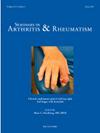Physical activity in patients with Sjögren’s disease: Compliance with World Health Organization recommendations and relationship with health-related quality of life
IF 4.4
2区 医学
Q1 RHEUMATOLOGY
引用次数: 0
Abstract
Objective
Physical activity (PA) can be beneficial for disease-related outcomes. Our aim was to investigate the types of PA performed, how many patients complied with the World Health Organization (WHO) PA recommendations and the association of PA levels with health-related quality of life (HR-QoL) in patients with Sjögren’s disease (SjD).
Methods
Consecutive patients from the RESULT cohort were included. The modified Short QUestionnaire to ASsess Health enhancing physical activity (mSQUASH) was used to determine the types of PA and compliance with WHO PA recommendations, consisting of aerobic PA (≥150 min), muscle strengthening (≥2 times/week) and functional balance (≥3 times/week) components. The associations between PA and HR-QoL (SF-36 domains) were analyzed using linear regression.
Results
245 SjD patients were included. Most frequently reported PA were household activities (91 %), walking (88 %) and cycling (62 %). Sports and exercise were performed by 55 % of patients; most often fitness, physiotherapy/sport, group lessons, swimming and yoga. In total, 92 % of patients fulfilled the aerobic PA component, 31 % the muscle strengthening component and 7 % the functional balance component. mSQUASH scores showed significant associations with SF-36 domain scores, with the strongest association for physical functioning (R2 = 0.19) and role limitations due to physical health (R2 = 0.17). These associations remained significant after correcting for age, sex, BMI, ESSPRI, ESSDAI and current immunosuppressive medication use.
Conclusion
Almost all patients with SjD performed aerobic PA, but patients could integrate more muscle strengthening and functional balance activities according to the WHO PA recommendations. Higher levels of PA were significantly associated with better HR-QoL.
Sjögren病患者的身体活动:遵守世界卫生组织的建议以及与健康相关的生活质量的关系
目的体育活动(PA)可能有利于疾病相关的预后。我们的目的是调查实施PA的类型,有多少患者遵守了世界卫生组织(WHO)的PA建议,以及PA水平与Sjögren 's disease (SjD)患者健康相关生活质量(HR-QoL)的关系。方法纳入来自RESULT队列的连续患者。采用改进的健康增强体力活动评估短问卷(mSQUASH)来确定PA的类型和对WHO PA建议的依从性,包括有氧PA(≥150分钟)、肌肉强化(≥2次/周)和功能平衡(≥3次/周)组成部分。采用线性回归分析PA与HR-QoL (SF-36结构域)的相关性。结果纳入245例SjD患者。最常见的PA是家庭活动(91%),步行(88%)和骑自行车(62%)。55%的患者进行运动和锻炼;最常见的是健身、物理治疗/运动、小组课程、游泳和瑜伽。总的来说,92%的患者完成了有氧PA部分,31%的患者完成了肌肉强化部分,7%的患者完成了功能平衡部分。mSQUASH评分与SF-36结构域评分存在显著相关性,其中与身体功能(R2 = 0.19)和身体健康导致的角色限制(R2 = 0.17)的相关性最强。在校正了年龄、性别、BMI、ESSPRI、ESSDAI和目前使用的免疫抑制药物后,这些关联仍然显著。结论几乎所有SjD患者都进行了有氧PA,但患者可以根据WHO PA建议进行更多的肌肉强化和功能平衡活动。较高的PA水平与较好的HR-QoL显著相关。
本文章由计算机程序翻译,如有差异,请以英文原文为准。
求助全文
约1分钟内获得全文
求助全文
来源期刊
CiteScore
9.20
自引率
4.00%
发文量
176
审稿时长
46 days
期刊介绍:
Seminars in Arthritis and Rheumatism provides access to the highest-quality clinical, therapeutic and translational research about arthritis, rheumatology and musculoskeletal disorders that affect the joints and connective tissue. Each bimonthly issue includes articles giving you the latest diagnostic criteria, consensus statements, systematic reviews and meta-analyses as well as clinical and translational research studies. Read this journal for the latest groundbreaking research and to gain insights from scientists and clinicians on the management and treatment of musculoskeletal and autoimmune rheumatologic diseases. The journal is of interest to rheumatologists, orthopedic surgeons, internal medicine physicians, immunologists and specialists in bone and mineral metabolism.

 求助内容:
求助内容: 应助结果提醒方式:
应助结果提醒方式:


